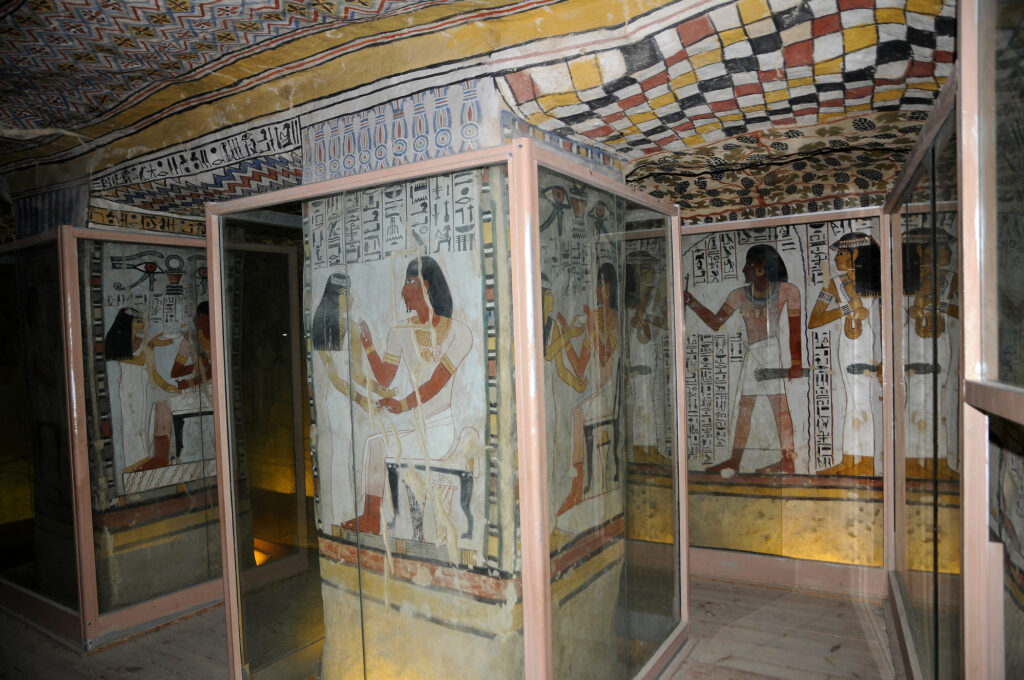Discovering the Cemetery of Sennefer in Louxor

Who Was Sennefer – The Mayor of Thebes
The Tomb of Sennefer is famous for its grapevine-decorated ceiling. It was uncovered in 1826 and is one of the largest tombs of nobles from the 18th Dynasty in the Theban Necropolis. Sennefer was a high-ranking official during the reign of King Amenhotep III around 1413 BCE. Due to his family ties and influential positions, he held titles such as hereditary prince, mayor of the southern city (Thebes), overseer of the grain stores of Amun, overseer of the bulls of Amun, and supervisor of the farmers. He was also the overseer of the beautiful cows of Amun-Ra and the overseer of the fields of Amun.
Emplacement and Historical Significance in the Valley of the Nobles
The tomb is located in the so-called South Hill at the top of a hill in the Valley of the Nobles in Luxor. This area is known for the tombs of elite officials from the New Kingdom, offering insight into the lives of Egypt’s upper class.
A Masterpiece of Tomb Art – The Tomb of the Vines
The Famous Grape Ceiling – A Unique Artistic Legacy
Le tombeau se distingue par son plafond décoré de vignes. Une grande partie du plafond est ornée d'un treillage ou d'une représentation de vigne, donnant l'impression de se tenir sous une treille chargée de gros raisins. Il s'agit du premier tombeau de l'histoire à utiliser une technologie tridimensionnelle. Le tombeau est constitué d'une seule chambre.
Religious Symbols and Daily Life Scenes on the Walls
The tomb’s walls contain many scenes and drawings in beautiful colors. One of the most famous depictions in the tomb is the harvest festival. Another large scene shows the grain storage of Amun, supervised by Sennefer. These vibrant artworks not only serve religious purposes but also reflect the wealth and duties of Sennefer.
Archaeological Importance and Discoveries
Excavation History and Preservation Efforts
À la surface se trouve une niche funéraire composée de trois salles transversales ornées de colonnes. Il est à noter qu'en 1905, cette niche servait à entreposer des antiquités découvertes dans d'autres tombes de la région, la plus célèbre d'entre elles étant celle de Toutânkhamon.
Insights into 18th Dynasty Burial Customs
The architectural style, artwork, and layout of Sennefer’s tomb provide scholars with important data on the customs and funerary beliefs of elite Egyptians during the 18th Dynasty.
Legacy and Symbolism of Sennefer’s Tomb
The tomb of Sennefer is not only a remarkable artistic achievement but also a rich source of historical and cultural symbolism that offers insight into ancient Egyptian beliefs about the afterlife. Sennefer’s unique status and close ties to the royal family are reflected in the detailed and symbolic decoration of his tomb. The grapevine ceiling, for example, is more than decorative—it represents fertility, rebirth, and the abundance of the afterlife, echoing the Egyptian hope for a fruitful eternity.
The scenes of daily life
The scenes of daily life depicted on the walls, including harvesting, winemaking, and grain storage, were believed to magically ensure these activities would continue for the deceased in the next world. Additionally, the presence of multiple depictions of his wife Meret highlights the deep emotional and spiritual connection between them, suggesting that love and companionship were highly valued in the journey to the afterlife. The tomb’s design and symbolism also reflect the broader religious shift of the 18th Dynasty, where increasing importance was placed on the individual’s relationship with the gods, especially Amun. Today, the tomb stands as a powerful testament to both personal legacy and religious devotion, offering visitors an intimate glimpse into the beliefs, values, and artistry of ancient Egypt.
Visiting the Cemetery of Sennefer – 2025 Travel Guide
How to Get There and What to Expect
Visitors can access the Valley of the Nobles on the west bank of Luxor, often included in tours that also visit the Valley of the Kings and Hatshepsut’s Temple. The tomb of Sennefer is well-preserved and known for its vivid artwork.
Tips for Touring the Valley of the Nobles
Wear comfortable shoes, bring water, and consider hiring a guide to explain the symbolism and history found within the tomb. Photography may be restricted, so check local guidelines before your visit.

